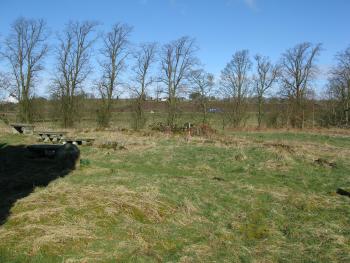- Navigation:
- Back to the Corpus index page
- RSS
Tullibole / Tulybothwyn Parish Church
Tullibole Church, from south east
- Dedication: unknown
- Diocese of Dunblane
- County of Fife
- Perth and Kinross Council
- NO 0546 0081
Summary description
The remains of the church consist of the partial outline of a basically rectangular structure marked chiefly by earth banks but with some masonry protruding, and there are possible traces of the platform of a structure to its east. Near its centre are the slightly more substantial remains of an inserted rectangular dry-stone structure.
Historical outline
Dedication: unknown
The church of Tullibole was granted in 1217 by Malcolm, earl of Fife, as part of his foundation endowment of the Cistercian abbey of Culross.(1) Both parsonage and vicarage teinds were appropriated to the abbey from the thirteenth century, but it emerges in the sixteenth century that only three-quarters of the revenues were enjoyed by the monks. The fourth quarter may originally have been taken by the bishop as a result of the papal award of the right to a quarter of the teinds of all churches in his diocese,(2) but the quarter from Tullibole was awarded subsequently to the dean of Dunblane. As an annexed church of a Cistercian abbey it is not listed in Bagimond’s Rolls. The church was served by a curate paid by the monks.(3) ‘Two parts’ of the church, apparently equal to three quarters, were set at rent by the abbey at the time of the Reformation, while one quarter of the church still pertained to the deanery of Dunblane.(4)
Notes
2. Theiner, Vetera Monumenta, no XCI.
Architectural description
The slight remains of the church are a little to the north of centre of the roughly oval graveyard, which is itself to the north-east of the policies of Tullibole Castle. The church appears to have been a structure of about 6.7 metres from north to south, with an overall length of about 24.5 metres, but with slight traces of a cross division about 3 metres from the east end. Although now largely defined by earth banks, stones protrude from those banks at a number of points. Projecting about 8 metres to the east of the principal remains are traces of what appears to have been the platform for a further structure. Built over the north and south walls of the church, about 11 metres east of the west wall are the remains of a rectangular drystone structure with an east-west length of about 5.6 metres, which rises to a maximum height of about 1.7 metres at its north-west corner. There appears to be no record of the function of this structure though, taking account of the continued use of the graveyard, it is possible it was built as a watch house. The oldest memorial found in the graveyard by the Royal Commission on the Ancient and Historical Monuments of Scotland was dated 1660.
In about 1614 the parish was united with Fossoway, and in 1729 a new church was built in a central position between the two churches. This was in turn replaced by a new church in 1806. Although the churchyard at Tullibole remained in use for burials, the church itself was demolished.
Bibliography
Cowan, I.B., 1967, The parishes of medieval Scotland, (Scottish Record Society), Edinburgh, 201.
Donaldson, G. 1949, Accounts of the collectors of thirds of benefices, (Scottish History Society), Edinburgh, 95.
Douglas, W., 1927, ‘Culross Abbey and its charters’, Proceedings of the Society of Antiquaries of Scotland, xl, 67-94 at 70.
Kirk, J., 1995, The books of assumption of the thirds of benefices, (British Academy) Oxford, 290, 315.
Royal Commission on the Ancient and Historical Monuments of Scotland, Canmore database.
Royal Commission on the Ancient and Historical Monuments of Scotland, 1933, Inventory of Fife, Kinross and Clackmannan, Edinburgh, 291.
Statistical Account of Scotland, 1791-9, ed. J. Sinclair, Edinburgh, xviii (1796), 446-7.
Vetera Monumenta Hibernorum et Scotorum Illustrantia, 1864, ed. A. Theiner, Rome, no xci.
Map
Images
Click on any thumbnail to open the image gallery and slideshow.








